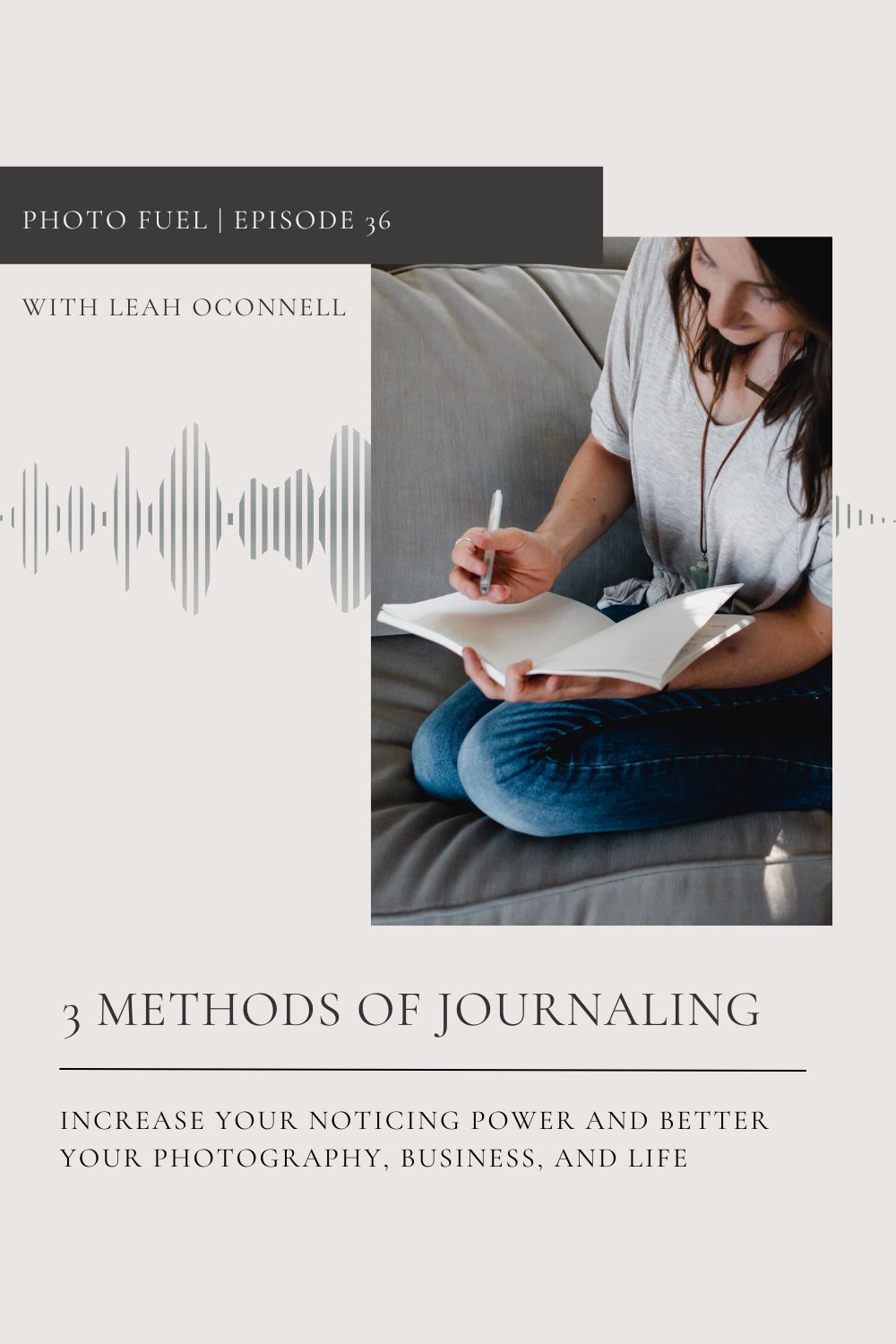In this episode of the Photo Fuel Podcast, I’m sharing 3 methods for journaling that I’ve tried and loved, depending on how much time I have and what I’m trying to accomplish. Journaling and photography are so intertwined. Establishing a regular journaling practice can increase your noticing power which inherently makes you a better photographer, but also brings clarity to your business and your life.
The best thing you can do to become more tuned in and capable of noticing is to record and reflect, so whether that’s with a camera or a pencil, the goal is the same.
I have gone through seasons of journaling in each of the three ways I’m going to share with you today. No matter which way is working for me in any given season, I’ve noticed that when I’m not journaling, I’m not as content in my life.
I have less material to think on and to share with others and I forget what I’ve just listened to or what I’ve experienced in a day.
It’s kindof what we build our whole careers upon as family photographers – this idea that the small moments matter, that we want people to experience their lives fully and deeply and with appreciation and joy.
And while I can’t always have a camera out around me, I do believe I need to walk the walk.
I am more readily able to help others with that if I’m experiencing it myself first.
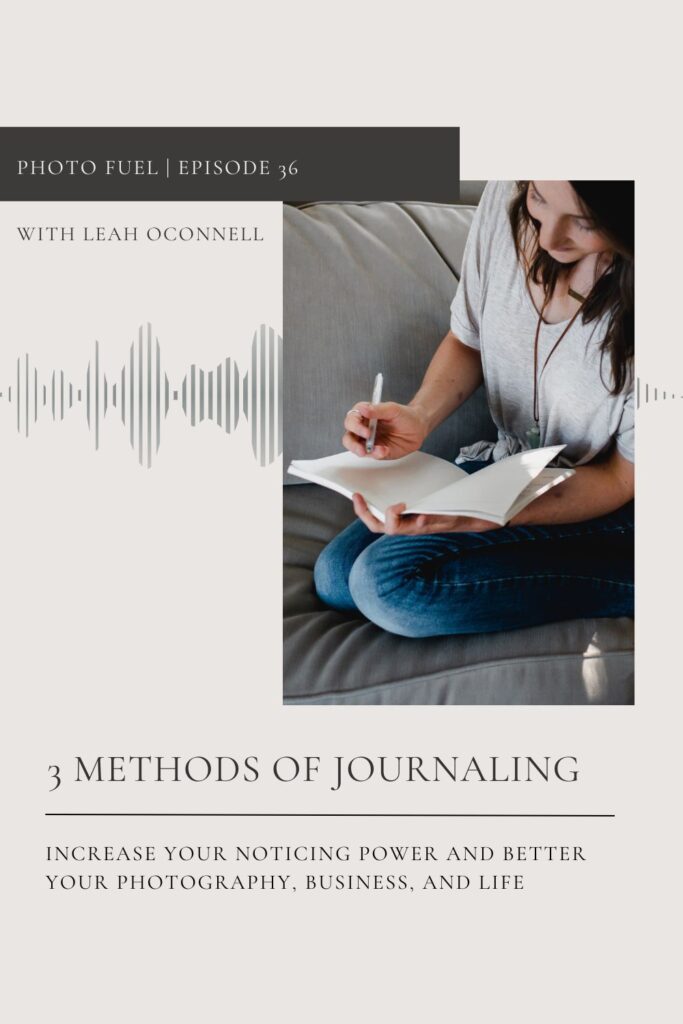
How Journalling Makes Writing for your Business Easier
Maybe you’re like me and simply want the words you put into the world to be intentional, not noisy.
But you also don’t want to spend hours of your work a week agonizing over captions for the sake of captions.
The solution I came up with as to how writing directly influences my work, is that when I journal, it’s often that the thoughts that come up and the stories that I write down can easily spark a topic for a newsletter and make that whole brainstorming process go away.
When I journal, I’m also first-drafting ideas for captions.
I’m getting to the heart of copy for my website or a blog post.
I’m connecting the dots between the things I do for myself and my family and the things I am making for other families.
So if you need more of a “reason” to journal, if you need to believe it’s more efficient or it’s not wasting time or it’s tied to your work in some way, that’s the way.
It will cut the mind junk and help you tune into yourself, your values, your desires, your gratitude – and all of those things directly influence the quality of the work you make from the images to the marketing to the client care and more.
3 Methods of Journaling
1. Morning pages
The first method of journaling is a longform practice by Julia Cameron made famous in her book The Artists’ Way – this is probably the most similar to the typical concept of journaling or a “brain dump” with a few stipulations, mainly that it’s a stream-of-consciousness thoughts, it’s longhand pen to paper, and it happens first thing in the morning.
You can write about your thoughts, feelings, ideas, worries, plans, or even mundane details. Everything is fair game.
There are no rules about grammar, punctuation, or structure. You simply write whatever comes to mind without overthinking or censoring yourself. No one ever sees it.
The reason this method is recommended for first thing in the morning is because It helps you capture your unfiltered thoughts and sets the tone for the rest of the day.
The main purpose is to clear the fog and free up mental space for creative and productive work. It can also help you reveal patterns in your thoughts that are red flags or perhaps even green flags for things you should pursue.
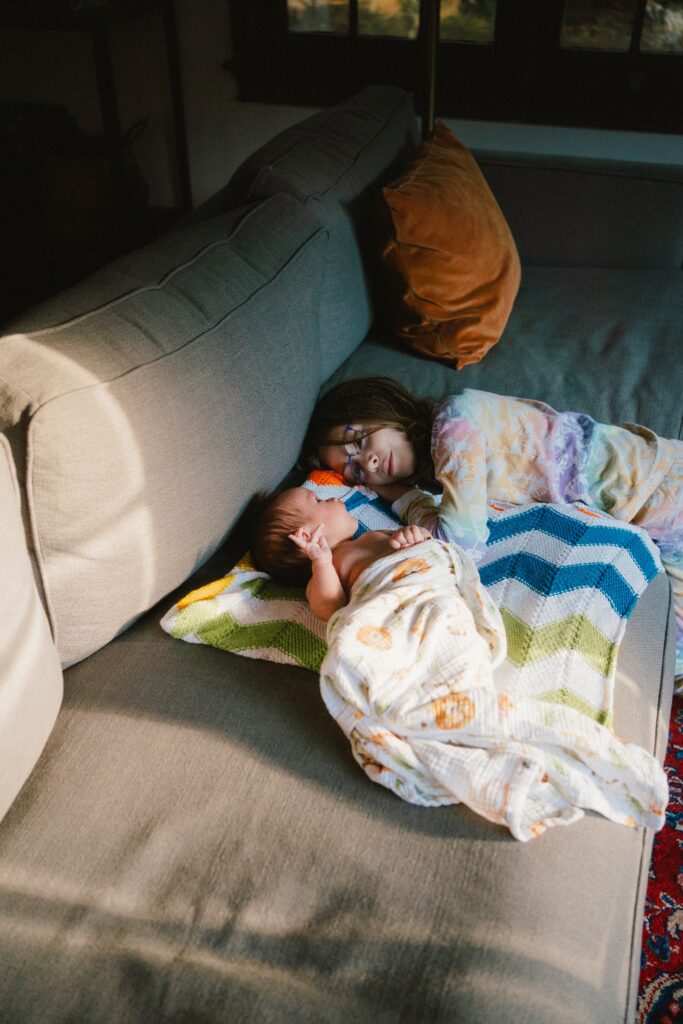
2. Bullet journaling
The second method of journaling is a concept developed by Ryder Carroll (watch the overview of the original process here).
It’s the opposite of Morning pages in that it’s a quick, shorthand system for recording tasks, events, and notes using bullets or lists. Unlike pre-made planners, you design your layouts (spreads) to suit your needs.
My favorite notebook for bullet journaling: Paperage dotted notebook:
In my bullet journal, I start with a page at the front for birthdays, then get right into headings for the month. Sometimes I will make heading pages for things like “Delight” or other lists. On the heading page for each month, I make a list of the books I’m reading that month and another for the TV or films I’ve watched. This helps me see at a glance what kind of media I’ve consumed through the year, which is really fun.
After that, I make 3 pages after each month’s heading-
“these are the days,” “what I learned” and “Notes.”
Then throughout the month I add bullet point notes to those pages. Every day I try to write something in These are the days but I always miss days and sometimes it’s more of a general overview of the week.
Sometimes it’s things my kids say. Sometimes it’s things about our current routines.
This is an example segment of these are the days from June:
- K’s first trip in the kayak – she wanted to go with me because she “just wanted to relax”
- G’s endless questions and desire to talk to everyone //
- going to the library with just the boys on a rainy morning //
- crying because I accidentally bought hot dog buns instead of hamburger buns and realizing that it wasn’t about the buns at all //
- not shooting much and feeling the urge to make pictures //
- a chick fila picnic outside in the yard in our bathing suits //
- anniversary dinner date at Fitzroy //
- code names, skulls and coronas with my brother and sister in law //
- living room campout and the Lego Movie //

In the What Learned page, I’ll include things I hear and remember from podcasts that month, things I unpack from conversations I’ve had, business lessons from things that worked or didn’t work, ah-ha moments, etc.
Lastly, in the Notes page, I’ll include anything from dinner ideas that went over well, to random ideas, to things I overhear or witness that are funny or interesting and more.
Read more: A meditation for family photographers (recenter yourself for your best work)
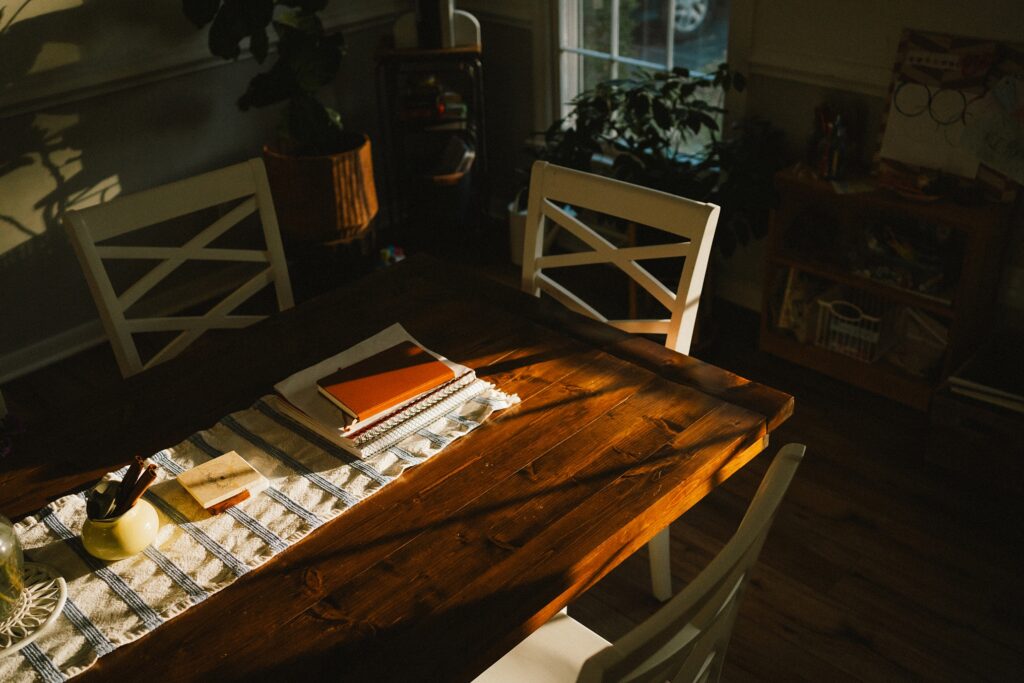
3. Homework for life
This last method of journaling comes from the book Storyworthy and a process developed by the author, Matthew Dicks. In this method, the goal is to end of each day by asking yourself,
“What’s the most storyworthy moment of my day?” and to keep or record of those moments.
A moment is “storyworthy” if there’s some shift in perspective, mood, or understanding – maybe a moment that evoked a strong feeling at some point during the day.
The moment doesn’t need to be dramatic—it can be something small, ordinary, or seemingly insignificant but the idea is to take that moment and determine the larger emotional resonance or realization from it. This can be done in a spreadsheet, which makes it easy to search for moments in the future if you want to develop any of those “storyworthy” moments into deeper reflections or content.
Create a format with three columns – the date, a brief description of the moment, and the key takeaway or insight.
Here’s an example from the book:
Date: [Day in the past]
Entry: My daughter grabs my finger as we walk through the grocery store. She doesn’t say anything. Just grabs it, holds tight, and keeps walking. It’s such a simple gesture, but it fills me with the kind of love that is almost painful.
Takeaway: A tiny, quiet moment that reminds me how fleeting her childhood is—and how much I need to savor it.
This entry captures:
- The moment: Clara holding his finger in the grocery store.
- Emotion: The overwhelming love and awareness of time’s passage.
- Takeaway: The realization of how important it is to cherish small, everyday moments with loved ones.
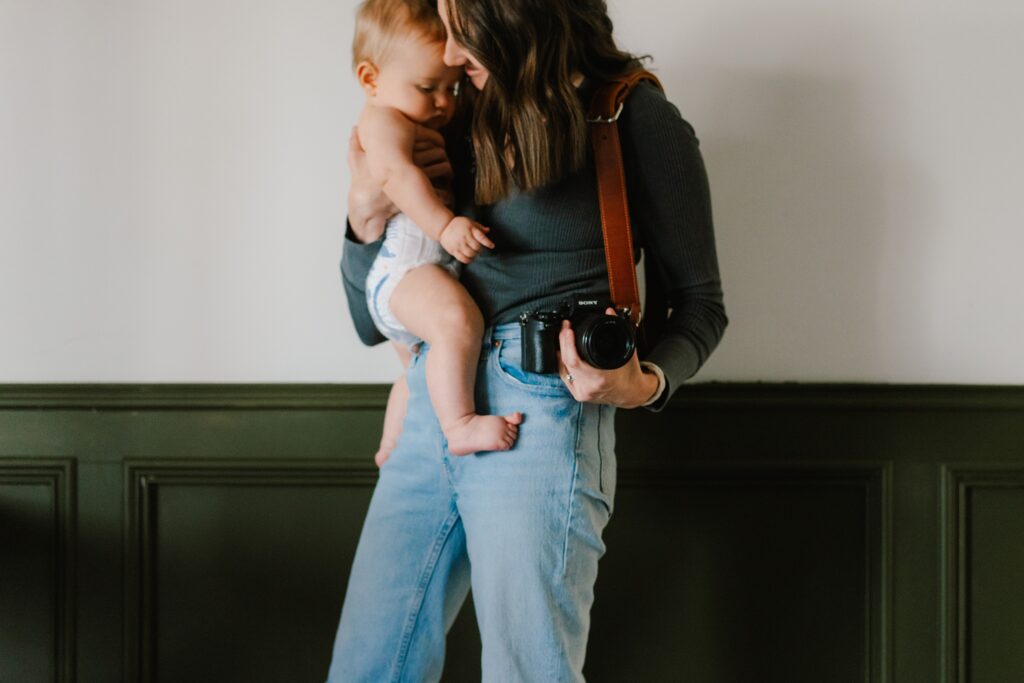
I hope these ideas give you a place to start with incorporating journaling into your artistic practice in the new year!
Listen on Spotify | Listen on Apple Podcasts
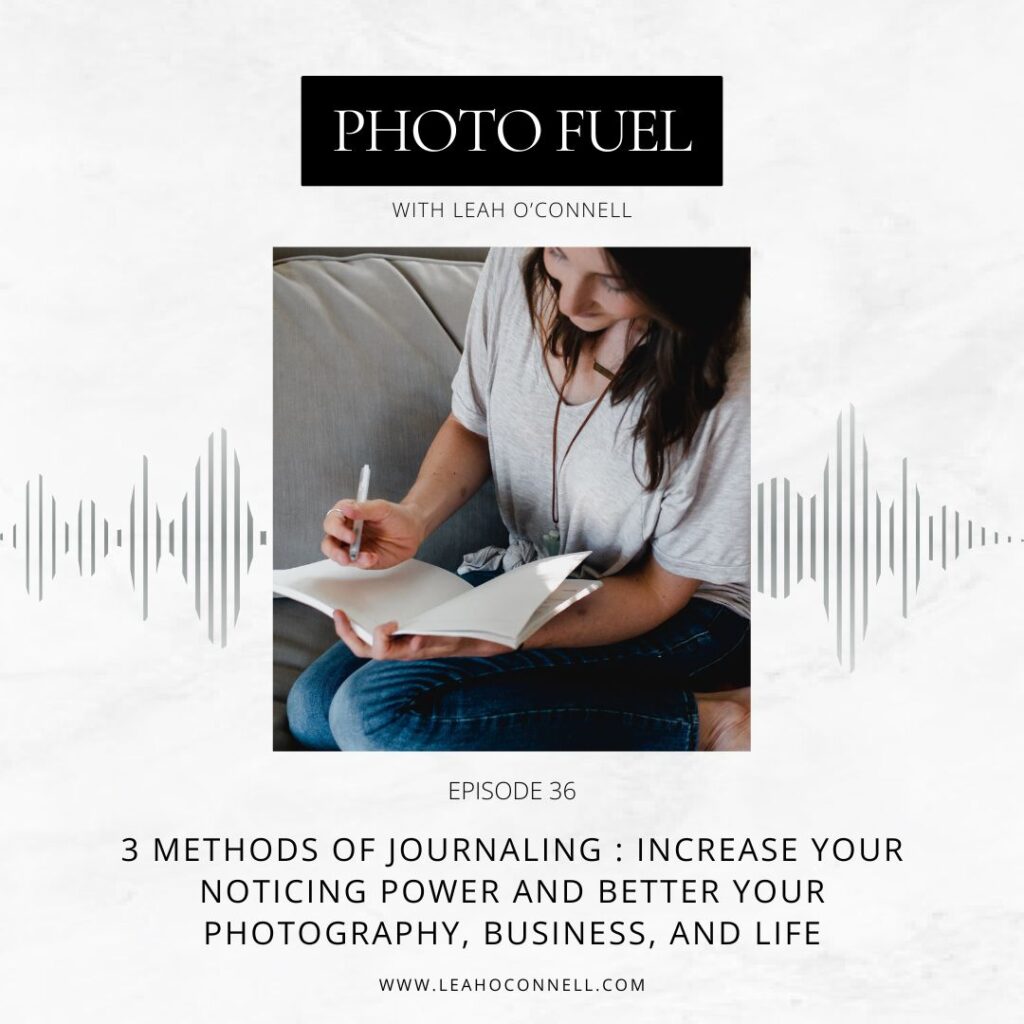
Links Mentioned in this episode:
The Artists Way by Julia Cameron
My favorite notebook for bullet journaling
Video introducing the original form of Bullet Journaling
Storyworthy book
